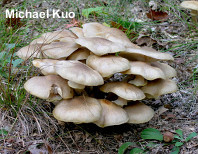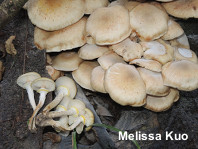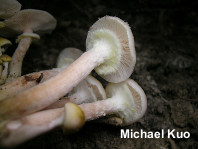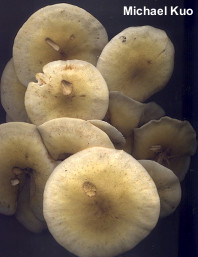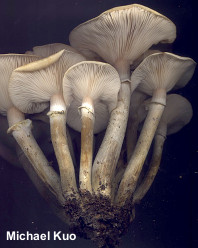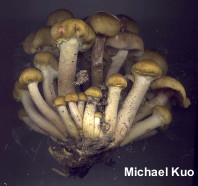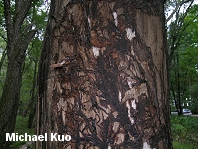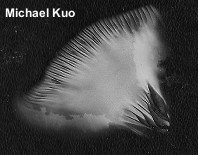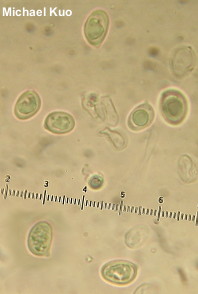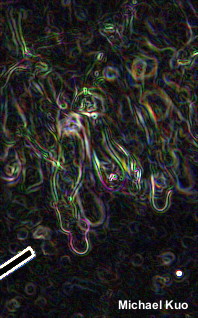| Major Groups > Gilled Mushrooms > Pale-Spored > Armillaria > Armillaria mellea |

|
Armillaria mellea [ Basidiomycota > Agaricales > Physalaciaceae > Armillaria . . . ] by Michael Kuo The classic "honey mushroom," Armillaria mellea, was first named from Europe in the 18th Century; here in North America it turns out to be limited to roughly the eastern half of North America, from about the Great Lakes to the Gulf Coast and the East Coast—although it has also been reported from northern California. It grows in tightly packed clusters, usually on the wood of hardwoods, but it is occasionally found on conifer wood, too. It has a fairly bald cap, a sturdy yellow-edged ring on the stem, and fused stem bases that are tapered to points. The spore print is white. Under the microscope, it has basidia that are not clamped at their bases. In the good-old days, not so long ago, there were two North American honey mushrooms: Armillaria mellea and Armillaria tabsescens—and the genus Armillaria held many mushrooms. This state of affairs was too easy for mycologists, however. Someone had to go and point out that Armillaria contained many mushrooms that differed widely in their physical features. More importantly, mycologists pointed out that the mushrooms in question differed in their fundamental ecological roles. Most of the honey mushrooms, for example, were parasitic wood rotters (often pathogenic and killing the tree), while other species of Armillaria were mycorrhizal. For a while mycologists played around with the idea of putting the honey mushrooms into a separate genus called "Armillariella," but eventually it became clear that most of the 250 or so species of Armillaria (not just the "honeys") needed to be distributed among other genera. Things snow-balled, and in the "end" many species wound up in Tricholoma, leaving Armillaria as a very small genus containing only a few species, most of which colonized wood with black, stringy rhizomorphs. Still not satisfied, mycologists had to go and "mate" the remaining Armillaria species in petri dishes. They discovered that some honey mushrooms would take to one another, while others turned up their fungal noses at the idea of pairing up. Thus, using the "biological species concept" (the concept we often use, for example, to define species of large animals: if they can't mate they belong to separate species), these mycologists defined about nine or ten species of Armillaria in North America. All well and good, except that some of these species don't look different, and must be "mated" to be identified with certainty. Fortunately, physical features do separate some of the species, and the fairly well documented geographical ranges of the mushrooms help to separate others (though some pairs of species, like Armillaria gallica and Armillaria calvescens, remain basically inseparable if the mushrooms are found in certain geographical areas). DNA-based studies (including Ross-Davis and collaborators 2012 and Tsykun and collaborators, 2013) have largely upheld the species defined by mating studies. Be sure to check out Entoloma abortivum to see what happens when the honey mushroom is attacked by another mushroom! Description: Ecology: Pathogenic and parasitic on the wood of hardwoods (and occasionally on conifers); causing a white, pulpy rot in the wood; spreading through wood, and from tree to tree, by means of long black rhizomorphs; typically appearing in large clusters on wood in the fall after rains, but found nearly year-round in warmer climates; distributed in eastern and southeastern North America, and in California. The illustrated and described collections are from Illinois and Tennessee. Cap: 3.5–12 cm, convex, often with squarish sides, when young; expanding to broadly convex or nearly flat in age; dry or slightly tacky; golden yellow when young and fresh, but soon fading to yellowish or brownish; bald, or with a few tiny, yellow to brownish scales concentrated near the center and vaguely radially arranged; the margin sometimes becoming finely lined with maturity. Gills: Attached to the stem or beginning to run down it; close; short-gills frequent; whitish, sometimes discoloring or spotting pinkish to brownish; covered by a pastel yellow to whitish partial veil before the cap expands. Stem: 7–20 cm long; 0.5–2 cm thick; equal above, but tapering to base due to the clustered growth pattern; fairly tough; often bald at maturity, but with whitish to pastel yellow flocculence from the veil when young; whitish to faintly pinkish near apex; becoming grayish to brownish below; with a thin but fairly persistent, white ring that usually features a pastel yellow edge. Flesh: Whitish to very slightly pinkish; unchanging when sliced. Odor and Taste: Not distinctive. Chemical Reactions: KOH negative on cap surface and flesh. Spore Print: White. Microscopic Features: Spores 6–9 x 4–6 µm; ellipsoid; with a prominent apiculus; smooth; hyaline in KOH. Basidia 2- and 4-sterigmate; lacking basal clamps. Cheilocystidia 25–40 x 2.5–10 µm; cylindric-flexuous to clavate, sub-lobed, or somewhat irregular; smooth; thin-walled; hyaline in KOH. Pleurocystidia not found. Pileipellis a cutis or ixocutis; hyaline to ochraceous or brownish in KOH; elements 5–10 µm wide, septate; terminal cells cylindric with rounded or subclavate apices. REFERENCES: (Vahl, 1790) Kummer, 1871. (Saccardo, 1887; Kauffman, 1918; Smith, 1949; Smith, 1975; Smith, Smith & Weber, 1979; Weber & Smith, 1985; Arora, 1986; Berube & Dessureault, 1988; Berube & Dessureault, 1989; States, 1990; Phillips, 1991/2005; Lincoff, 1992; Metzler & Metzler, 1992; Horn, Kay & Abel, 1993; Barron, 1999; Roody, 2003; Volk, 2003; McNeil, 2006; Miller & Miller, 2006; Kuo, 2007; Binion et al., 2008; Ross-Davis et al., 2012; Tsykun et al., 2013; Kuo & Methven, 2014; Desjardin, Wood & Stevens, 2015; Siegel & Schwarz, 2016; Woehrel & Light, 2017; Baroni, 2017; Elliott & Stephenson, 2018.) Herb. Kuo 09200101, 09230608, 05210701, 09271501. This site contains no information about the edibility or toxicity of mushrooms. |
© MushroomExpert.Com |
|
Cite this page as: Kuo, M. (2017, May). Armillaria mellea. Retrieved from the MushroomExpert.Com Web site: http://www.mushroomexpert.com/armillaria_mellea.html |
